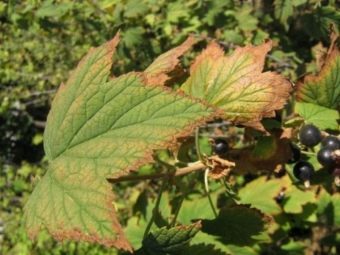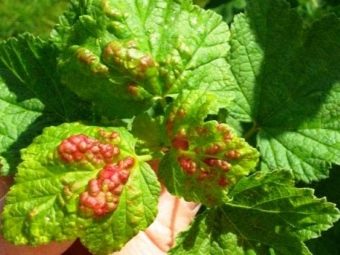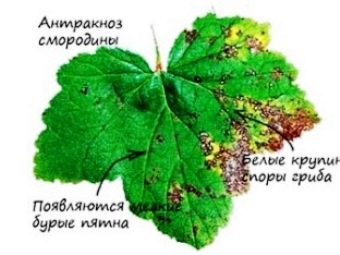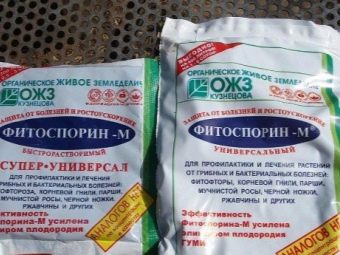Currant Anthracnose: Symptoms and Treatment Methods
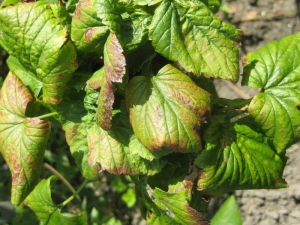
The currant once enjoying its fruits does not look good? Maybe on the lush foliage appeared small brown spots? Or, instead of small dark dots, leaves are dotted with red bumps that look like an ulcer? One way or another, you shouldn't panic. But you need to act, because in your garden, probably, a fungal disease called anthracnose has appeared. And how exactly to act in order to enjoy the usual harvest again will be described in this article.
What is this disease?
Anthracnose is a fungal disease caused by marsupials. Both the black and red currants are affected by the same fungus, although it changes its shape depending on the type of fruit bush. This, in turn, makes small differences in the course of the disease. The fungus itself is quite treacherous in nature. It hibernates on previously infected and fallen leaves, and in the spring its spores move to new open spaces along with water flowing past or clinging to insect legs.
As is typical for any fungus, active growth will take place in a humid environment at a favorable temperature (+ 21-25 degrees). It is worth noting that the form of the disease affecting black currants is characterized by a more stable perception of low temperatures.
Signs of defeat shrubs
As it is already clear, this fungus infects the deciduous part of the plant, beginning to manifest itself with small dark dots and turning into a continuous affected space of red or brown color. And this will continue until the currant leaves perish and fall to the ground, thus becoming the carrier of the disease. But this may not all end. If the plant was previously weakened by a frosty winter or other disease, then, in addition to foliage, anthracnose will damage the stalks, young shoots and stalks.
All these parts of the bush will be covered with the same small dark spots 1 mm in diameter. And, of course, if the infection did not stop on the leaves, then it will affect the fruits themselves, covering them with light red spots. Under these conditions, the yield loss of black or red currant will be enormous, and the degree of damage will be more than 50%.
Control measures
As with any other disease, treatment should begin as soon as the first signs appear. Of course, it is better to try to prevent the appearance of the fungus, but this will be discussed later. Before considering more crude chemical means of solving a problem, you need to turn to folk remedies and proven methods.
Folk remedies
If anthracnose struck the bushes at the end of fruiting and did not have time to develop properly, then an inexperienced gardener can easily think that the problem has passed. It is a pity, but it is not. If the threat has arisen, then in any case it must be eliminated, since the currant's immune system is unlikely to cope on its own.
One of the ways to help conquer the disease is to scald the bushes with boiling water. For implementation, you need to heat the required amount of water so that at the time of spraying the temperature is around + 70 degrees. Treated are bushes with unblown buds. Dissolved iodine in water also shows good results. Only 1 drop per liter of water can help. For best effect, it only remains to preheat the water to room temperature.
The laundry soap not only scares off small harmful insects, but also treats anthracnose. To do this, it will be enough to rub half a bar of soap and stir it in a bucket of water (about 10 liters). Naturally, in warm water to carry out the procedure better and faster. Another popular method of folklore is garlic tincture. Garlic is famous for its ability to fight parasites of different levels. And this fungus, he also will not leave a chance for a quiet life. For cooking means you need to insist in a bucket of warm water 150 g of shells from garlic cloves. After a day the liquid is ready for use.
In fairness it should be noted that all these methods are mainly aimed at preventing the disease or fighting its mild and inactive form. In the peak stage of infection, one should not wait for a guaranteed result, but before using chemical exposure it is still worth trying folk methods. You can not pass by such an ambiguous drug for this category, as Bordeaux liquid. The fact is that its production from scratch at home is not possible for an ordinary person, but for more than a century this tool has been popular with gardeners. So it can already be said to have earned the title of the people. And it is not from scratch.
The drug is truly universal, if we talk about the fight against fungal or bacterial diseases. After application, you can not exactly be afraid of copper deficiency in the plant. And compared to other fungicides, Bordeaux liquid does not lead to calcium deficiency.
The drug can be prepared and most of the already finished items. There is nothing complicated here, since they are only 2: copper sulphate and milk of lime. Prepare, as a rule, 1% or 3% solution, depending on the application. To prepare the 1% concentration, you will need 100 g of copper sulfate and 100 g of lime. In separate non-metallic containers, the two ingredients are mixed with 1 liter of hot water. Then, gradually adding cold water, the volume of liquid in both tanks is adjusted to 5 liters each. And after obtaining a homogeneous mass, the solution of copper sulphate slowly filter, adding to the container with lime mortar. The resulting mixture is thoroughly mixed and used when anthracnose was seen already during a riot of greenery.
For early spring or autumn processing, a 3% solution is perfect. There are no difficulties with its obtaining either, since the procedure hardly differs from making a less concentrated mixture. Only instead of 100 g of substances, 300 g is taken, they are dissolved in 2 liters of hot water. Then the procedure is repeated without changes. After the final stage, it remains only to check the pH of the mixture with litmus paper. It is necessary to achieve a neutral acid-base balance (pH), i.e. the solution should paint the paper blue.
If this staining does not occur, and the color goes to red shades, it is better to add a little more milk of lime to normalize the acidity.
Bordeaux liquid to apply according to the instructions. Since this is still a drug of artificial origin, one can easily be mistaken with its concentration and frequency of use. And if such a mistake turns into a systematic one, there is a risk in 5-10 years to bring the plants to death, and the soil in the area to complete unsuitability. And though it is a small, but an environmental disaster. But to that summer resident who carefully and competently spends resources, such trouble does not threaten never. And already there, where the above-listed methods failed, in the course you can start up modern agricultural developments.
Special preparations
Microbiological
Unfortunately, folk methods are not always enough for all occasions. And if the cottager is not a supporter of the chemical effect on the cause of the disaster, then you should take a closer look at microbiological preparations. This is a relatively new trend in crop production. Their principle is that they bring antagonists to the causative agents of the disease, who come into confrontation with the pathogen and win. And the summer resident at the end receives a healthy plant without harm to himself and the environment.
- "Gamair". This drug is mainly aimed at combating bacterial diseases, but it is also able to cope with some fungal diseases, in particular, anthracnose. "Gamair" is neither dangerous for humans nor for animals, so it can be used at any stage of the disease. However, this tool does not accumulate in the soil and fruits.This means that the harvest can be eaten immediately after the treatment of diseased bushes. But it is better to follow the advice of the manufacturer and enjoy the berries the next day.
- "Fitosporin-M". Another find for supporters of organic farming. Users argue whether it is better or worse than the “Gamair” described above, but we can safely say that Fitosporin-M is also effective in the fight against anthracnose.
Classic fungicides
You can use the following drugs.
- Means "Topsin-M" effectively copes with both small insect pests and fungal diseases. After watering or spraying currant bush, "Topsin-M" penetrates the plant and spreads throughout the system of blood vessels. From within, it begins to suppress the growth of a pathogenic culture, preventing the production of new spores. The use of the drug will not pass completely without a trace for the surrounding flora and fauna, but it is worth noting the low toxicity of the drug. Most of all it does not tolerate fish, so you should not actively use the "Topsin-M" near water.
- "Vaccine" has a similar mechanism of action with the above-described drug and has the same toxicity class. As a feature, the indirect influence of funds on the growth of culture can be noted. The fact is that during the fight against the pathogen, the plant changes the work of the immune system, which, in turn, is associated with metabolism. After the application of "Privicer", the metabolism is accelerated, which has a positive effect on the growth of the root system.
- "Fundazol" also penetrates with the water into the vascular system of the plant and has a detrimental effect on the fungus. Unlike previous fungicides, this one is more toxic and lasts longer on the plant and inside it. On the one hand, this forces the grower to use the drug more carefully, on the other hand, leaves the fungus less likely to survive and adapt. At the same time, Fundazol does not harm the culture itself.
Prevention
In order not to wrestle with what kind of fungicide to use, and not to be afraid of damaging the health of the rescued fruit, it is better to eliminate the risk of infection as much as possible. For this there are a number of simple actions.
- Thin currant bushes once a year. After all, a plant with dense foliage will not allow evaporation of moisture to evaporate, and this, in turn, will serve as a good environment for the development of all types of fungi.
- Remove thick weeds around fruit bushes. This measure will provide additional space for improved plant ventilation.
- Highlight for the culture illuminated and moderately purged place. The essence of the method again comes down to eliminating excess moisture.
- Dig the soil in early spring around the plant. This will help to successfully eliminate overwintered pests.
- Autumn collection of foliage with its subsequent burning will save from anthracnose, even if he has already managed to settle on currants, but he did not have enough time to prove himself.
- Timely application of organic fertilizers. Again, do not forget that weakened plants are a more favorable environment for the development of fungal and other diseases. Therefore, timely fertilizing will allow the immune system to fully function, reducing the risk of infection.
From all of the above, an unambiguous conclusion follows: if favorable conditions for the development of fungal diseases develop in the garden plot, then prevention will be the best fight. By spending a little extra time on this, you can prevent not only anthracnose, but also a number of other similar diseases.
In the next video, the author tells how to get rid of pests on currants without chemicals.


